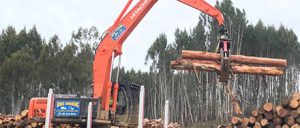New Zealand Forest Owners Association President Phil Taylor is cautioning foresters about jumping the gun getting back to work tomorrow after the lockdown, and that health and safety on the forest work site goes well beyond the COVID-19 protocol observance. Source: Timberbiz
He says the various parts of the supply chain will be back in operation under Alert Level 3 after nearly five weeks of not working, and in some instances even longer.
Some forestry businesses continued under Alert Level 4 to process wood for essential goods such as wood for pallets and fuel, and pulp and paper for products such as food and medicine packaging.
“The forestry sector has told me they are raring to go. With forestry being among the first industries affected by the fallout from the COVID-19 pandemic, it’s great that businesses across the supply chain are ready and waiting to get back up and running. This includes harvesting, which employs 7500 people,” New Zealand Forestry Minister Shane Jones said.
“When a sector as big as forestry, which employs 30,000 people across the supply chain nationwide, grinds to a halt, the knock-on effects are huge. The resumption of work at level 3, with strict safety and social distancing protocols in place, is very welcome news.”
The Government says that it is committed to supporting all parts of the forestry sector to restart, and ensuring the industry remains financially supported in the meantime.
“We’ve kept an eye on the essential services supply chain and adjusted it as needed, while supporting forestry and wood-processing sector businesses with wage subsidies,” Mr Jones said.
Uptake of the Government’s COVID-19 wage subsidy has been very high among forestry businesses. Nearly 90% of respondents in a Te Uru Rākau forestry sector survey undertaken on 31 March reported they were either receiving or had applied for the subsidy. This covers 4467 fulltime and 75 part-time employees. According to Mr Jones further announcements to support the forestry sector and its large workforce will be made in the next few weeks.
“The lockdown was unscheduled and had to be rushed through in the course of just two days as we went on to Alert Level 4 and forestry was not deemed as an essential industry. In some places we had to just leave logs on the ground where they were harvested,” Mr Taylor said.
“Our work sites are complex operations and, even when their closedown is planned, there has to be a lot of testing and checking for safe operations before work fully resumes.”
That includes checking machinery and equipment as well as the earth and roading works in forests.
“We haven’t had much rain over the past month luckily, but nonetheless our forests are a natural environment and things will have potentially changed quite a bit while we have been absent.
“As well, a number of forest companies have reported acts of vandalism during the lockdown which is obviously disappointing, and we need to check for any sabotage.
“Fortunately, we are allowed to inspect and prepare sites in the days before the supply chain starts up again. I hope everyone gets to do that.
“But clearly the biggest change when we start up will be complying with the COVID-19 protocols to protect workers for the coronavirus. Our Forest Industry Safety Council has worked through the supply chain to develop a refined set of safety protocols, mostly about safe distancing and cleaning down equipment, and we expect those rules to be complied with, for everyones’ sake.”
Mr Taylor said that while the whole supply chain is keen to get back to production and for workers to start earning some income again, it would be hugely disappointing to be the sector responsible for the disease rate to go back up again and for New Zealand being thrust back in to Alert Level 4.






